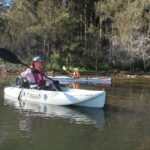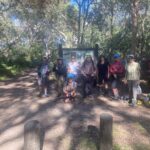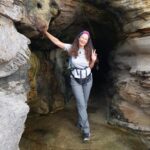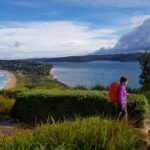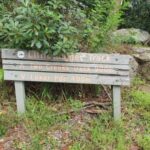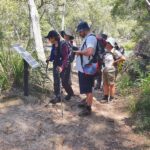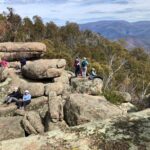Bunya Mountains Trip, Bunya Mountains and Girraween National Parks, Clarence Valley Bushwalking Club
Ray Bulmer originally conceived the idea of the annual trip to Bunya Mountains and Girraween National Parks for our bushwalking holiday. He put in a huge amount of preparation and drew up a great itinerary with a good mix of walking and sightseeing with some wonderful places to stay. Unfortunately he was not able to come on the trip due to ill health and we missed him greatly.
The group consisted of Michael, Christine, Steve, Moira, Joan, Jan, Stephanie, Kent, Narelle, Stuart. We set off on Saturday September 7th. As we left our area in Gulmarrad we remarked on how much the Shark Creek fire had grown in the last day and then we drove off towards Grafton, never guessing the fire would grow so big in the next few days whilst we were away. Fires were starting up all over the valley and throughout NSW and this was to be a constant theme throughout the holiday. We packed our car up in 35 deg heat, with the sky turning orange and filling with smoke.
We consulted the night before on the best route to avoid fires and some of us kept to Ray’s original route via Glen Innes. We stopped off for the obligatory coffee break at McDonald’s in Glen Innes and a second breakfast. Others travelled via Kyogle. We passed through Stanthorpe and Tenterfield, witnessing the burnt areas from their bushfires only the day before. They had burnt both sides of the road in some places up to people’s garden fences so it was a sobering reminder of our vulnerability. We were all able to meet up at Warwick for a late lunch. Then we pressed on to our first overnight destination, Jondaryan Woolshed. We were saddened to see how dry the countryside was along the way. We set up camp in their campground and hunkered down for our first dinner in an increasing wind.
The next day we explored the extensive historic site at Jondaryan and there was certainly a lot to see. But first we had to have a hearty breakfast at their café. This was bushwalking in style. Then we visited the many historic buildings, the largest being their magnificent Woolshed itself. Many of the historic buildings had museum displays inside them. The school was one of the most interest.
The next day we set off for the short distance to Maidenwell which we were going to use as a base for our first set of walks in the Bunya Mountains National Park. The camping areas in the National Park were not accessible for some of the group so we had opted for the comforts of Maidenwell Pub.
We arrived at the camping grounds in the Showground at the rear of the pub and set up. The wind had increased even more and Michael had to secure the tent to the car with 3 ropes to ensure it did not blow away. Most of the group went for a preliminary walk to Coomba Falls which was a steep and interesting walk but little water. Later on we availed ourselves of a welcome dinner at the pub and a game of pool, hoping the wind would abate, but it did not. That night we fell asleep listening to the wind gusts.
The next day we set off on the 25k trip to Bunya Mountains National Park and were amply rewarded by the display of wildlife as we had morning coffees at the cafe. The wallabies and birds were very tame, no doubt owing to the proximity of the café. Bushwalking in style yet again. But the coffees at the end of the second day’s walking were very welcome.
We set off, stopping first for a view from the high point of Mt Mowbullan which had an extensive panorama but a lot of smoke haze.
We set off on our first walk along the Scenic Circuit and walked through beautiful rainforest areas with abundant bunya and hoop pines. It was a welcome change from the dry landscape we had travelled through to arrive there. There were many other sights to see such as extensive strangler figs, stinging trees (look but don’t touch!), bird’s nest ferns and staghorns. Unfortunately the many waterfalls were nearly all dry. Two of the group elected to return to the starting point by a shorter route where we saw a red bellied black snake and many different species of beautiful trees whilst most of the group carried on to Big Falls and Barker Creek Lookouts. …….
It had been arranged that a car pick up would take place at Paradise Park but through mis-communication this did not happen so some members got a longer walk than they bargained for. This emphasised the need for clear communication on walks. But we all reconvened at the end for some much needed bunya nut ice-cream in the café.
That night we indulged in another meal at the Maidenwell Pub.
The next day we set off to the National Park again and walked the Westcliff Lookout walk. The northern walks were partly escarpment walks and we had some good views from the lookout and along the way, although they were not at their best because of the smoke from the extensive bushfires. We stopped temporarily at Westcott and then all but one continued on along the Koodaii Circuit loop walk.
Our final walk of the day was to the highest point of the National Park, the Mt Kiangarow track to the summit and back. It was a short but lovely walk through the scrubby bush with smatterings of rainforest. We admired the extensive arch of grass trees and wildflowers with an extensive view of the valley below at the end.
After coffee once again we returned to camp and decided to tough it out and actually cook for ourselves like real bushwalkers should. We fortified ourselves with Happy Hour first though. Up until that point Happy Hour had not been that happy or extensive, downright non-existent owing to the strong, cold winds. The winds had dropped a little and a welcome use was made of the awning of Stuart’s caravan for a few drinks and nibbles. We had a discussion in which we confirmed that unfortunately Girraween National Park, our next walking destination was closed due to the threat of bushfires. Some fires were still active in the area and some were growing, including the large one near Drake and the Bruxner Highway on the way home.
All this while Michael and Christine had been monitoring the ever increasing Shark Creek fire near our home via the RFS website and wondering if there would be anything left of Yurygir National Park at home for future walks. What had started out as a tiny fire weeks ago had grown to threaten Woolaweyah, Angourie and Yamba.
The next day we changed our plans and spent the day in Toowoomba sightseeing. We enjoyed the wonderful flower displays at the Queens Park Botanic Gardens, where we were lucky enough to see their preparations for the Flower Festival in a few weeks’ time, followed by lunch at the Cobb & Co Museum and a look at the extensive displays there.
After that we headed south to our planned camp at Sommerville Tourist Park. This had been planned as our base for walking in Girraween National Park as that has been closed for a while due to water shortages in the park. It was now also closed due to bushfire risk so we stayed for only one night there and enjoyed their lovely facilities but once again braving cold weather of about zero degrees. We set off home the next day by mutual agreement, cutting the trip short. Some took advantage of the shortened trip to go their separate ways and do other activities but walking trails in National Parks seemed to be in short supply.
We travelled south again and most stopped at our planned lunch break at the Standing Stones Cottage where Ray had thoughtfully booked a surprise birthday tea for one of the group. We procured two cakes and a candle as there were two birthdays to celebrate. We then headed down the range to arrive home.
Clarence Valley Bushwalkers Inc. was founded in 1997 by a small Group of interested bushwalkers. Since then membership has grown to approximately 90 members.
Walks are held in a range of beautiful areas including New England National Park (including Cathedral Rocks, Woolpack Rocks, Point Lookout), Washpool National Park and Gibraltar Range National Park (including Anvil Rock and Dandahra Crags). The Club also canoes and kayaks local rivers and holds relaxing bicycle rides around Clarence Valley.
There are up to 5 scheduled club activities per month. These can include bushwalking of varying levels of difficulty, terrain and duration; kayaking/canoeing trips and overnight car-camps; full-pack weekend walks, social outings, and bicycle rides. The Group also undertakes interstate and overseas adventures. Activities that are dependent on suitable weather or tidal conditions can also be added to the program at short notice to take advantage of favourable conditions.


